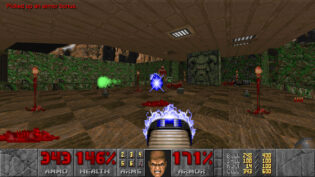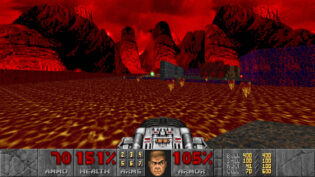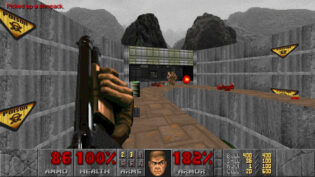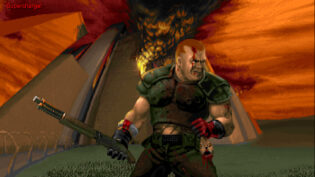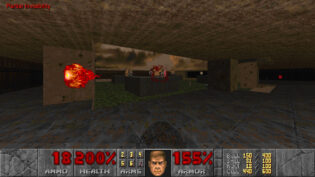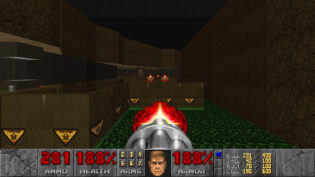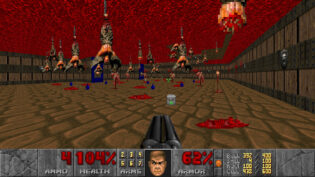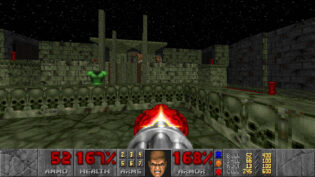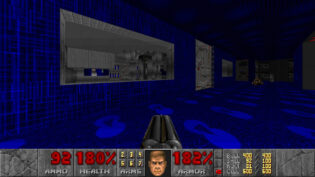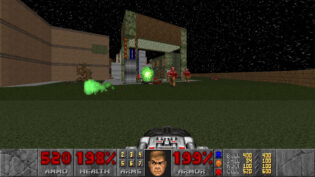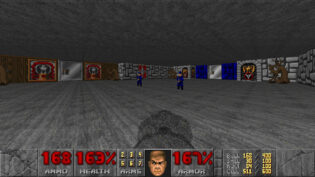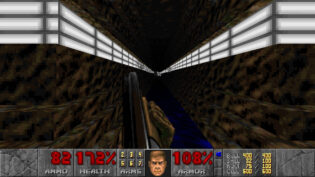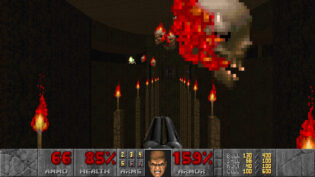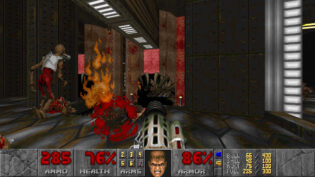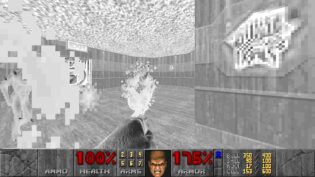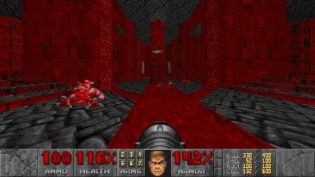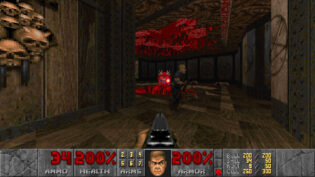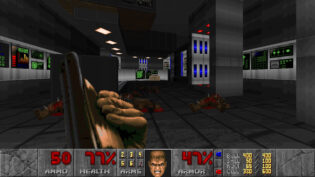O tempora is a series of retrospective posts where I play games from ages before to see if they stood the test of time.
Well, it finally happened. I’ve finally played both classic Doom titles start to finish and even all of its official expansions. It might sound weird to some, given how huge and important Doom has been for the development of FPS and game industry as a whole, but it just so happened that I was never much of an id Software games player. Even though Spear of Destiny was my first introduction to this type of games, I just never really played through any of their titles start to finish until decades later. Which includes the classic Doom games – I have played and finished the original Doom (that is, the first three episodes) a very long time ago, but I’ve never played any other title in its entirety apart from the Playstation version of the Final Doom, which was my only point of contact with the Doom II expansions. And yes, I did get it back in the day, because I thought it was the “final definitive version of Doom”, not realizing that it’s a completely different game…
But now Doom and Doom II have been officially re-released on all modern platforms in a remastered package by NightDive, with all of the official, and even some previously unofficial, releases combined into one game. And I’ve decided that it was finally time to give it a proper go.
First of all, I want to talk a bit about this new remastered version of the game. You still have access to all of the original DOS versions of the games so you could use a different source port of your liking, which is extremely important for the Doom modding scene. And while this new version intends to be the new “intended” standard for experiencing Doom and its mods (usually known as WADs), this remaster may not run all of the existing ones properly, if at all. Different source ports changed what Doom can and cannot do in very major ways and one of the most popular modern ones – GZDoom, – by now became almost its own engine with a huge amount of features. So if you were considering playing the surreal “myhouse.wad”, that received a lot of positive attention last year, you would still need to run it under GZDoom source port.
Apart from that, the new version of the game includes previously well known releases The Ultimate Doom (that is Doom and additional fourth episode), Doom II, Master Levels for Doom II and both parts of Final Doom (TNT: Evilution and The Plutonia Experiment). And on top of that it adds No Rest for the Living (from the 2010 XBLA port of Doom II), John Romero’s Sigil from 2019 (for Doom) and a completely new two part expansion for Doom II called Legacy of Rust, created just for this collection. Mods are now downloadable from within the in-game service (which is slightly awkward, but somewhat convenient) and games feel “like you remember them”, which means not like they used to be but with additional quality of life improvements. Settings are very simple, in contrast to typical source ports, but you get to play the games with several really cool options for the soundtrack. Big selling feature is the fact that Andrew Hulshult re-arranged all tracks from Doom II on top of his old remix album of Doom 1 tracks and you can play the game listening to that, or instead stick with the original MIDI which has been specifically recorded off the exact same model of the MIDI synth that Bobby Prince used when he recorded the tracks. Unfortunately, the wonderful dark ambient tracks by Aubrey Hodges which were available in the Playstation ports of Doom are not present.
What about the games themselves? They are important and classics for a reason, but are they as fun as they used to be?
The original Doom still feels very fun, despite being so old. Sure, people love to talk about how the first episode feels the most polished and well paced, but all three original episodes are great and maps start to falter only in the very late parts of the last episode. There’s certain enjoyable simplicity and fun to the levels, weapons feel fun to use and the enemy types and their placement often feels “just right”. Going through the three episodes is still an extremely fun experience that gradually builds up to a cool final boss fight and if I’m being honest – if the remaster consisted of just the original Doom it would’ve still been worth it. In fact, I might’ve even loved it more. The additional fourth episode from The Ultimate Doom is, however, a shape of things to come. It has several alright maps, but is overall terrible, it’s balance is completely off and I don’t think there’s reason to play it for most people. Oh, and also it was weird to remind myself that the classic Doom titles did get a lot of pitch black rooms, which Doom 3 infamously focused on, and while you can add additional lights in the options to make things a bit brighter, the original experience can be very dark at times.
Before we go to the sequel, let’s mention Sigil, as it’s now included as part of the official package, even if it still remains an unofficial fifth episode of Doom. Now, it is better than the fourth episode, but is full of its own problems. A lot of it is designed around finding switches you have to shoot, which are sometimes pretty annoyingly hidden, a lot of enemy spawns are more frustrating than surprising and some of its levels sections seem to exist only as a gimmick. I enjoyed playing it more than the fourth episode, but not by much and feel like it still misses the point of what made the original Doom feel so good. Oh and not included in the collection is Sigil II, also by Romero, which I didn’t even finish because it was way too frustrating to play. It seems to get better, but it’s just not going in the direction I care about.
Anyway, after the original game was released via the shareware and became a huge hit, id Software decided to make Doom II a boxed retail release and developed it in less than a year. And it’s weird. On one hand, it’s so similar to the original game in a different era it could’ve been criticized for doing “not enough new stuff to be a sequel”. On another – the whole game is very differently designed around the same basic mechanics. There are no “episodes” in Doom II and instead you get a sequence of 32 levels (2 of which are secret). There are general “themes” for the visual style of levels to give you a similar sense of progression as what episodes did in the original, but things blend together much more. Maps in general feel… different. On one hand, I feel like the introductory levels in this game are fantastic and flow really well. On another – things become very big and open and confusing as the game goes on, apart from several wonderful gimmick levels. Super shotgun, which is introduced and becomes almost the main weapon of choice for most of the game. And there are new enemies… ugh.
Most of the additions to the bestiary in the game are quite bad. Sure, we all love Revenants, the funny doot skeletons, but they’re actually quite frustrating to deal with in some situations. And they’re the best new addition. The “Heavy Weapons Dude” can ruin your life without you even seeing the enemy, Pain Elementals and Arch-Viles are just horrid to deal with and even the Mancubus can be annoying depending on how the level designer places him. There are more enemies on maps as a whole and more “boss-like” enemies popping up here and there, requiring a huge amount of ammo to deal with. The game, in general, just feels quite a bit more tedious to go through in comparison to the original and the final boss fight in the game is just dreadful. But it’s still a solid game and its mechanics became a great base for the official expansions and infinite amounts of mods.
The first official expansion released by id was Master Levels for Doom II, which in its original version wasn’t even really an expansion and rather a collection of 21 maps (20 proper levels and a secret) that could be played in any order. This new updated collection instead turns it into a proper expansion with levels going in sequence and also unfortunately showcasing how completely uneven these maps are. Some of the levels here are incredibly good, much better than some of the levels in Doom II itself. Some of the levels are insufferably terrible. It’s at this point it also becomes clear how some of the mappers don’t consider the consistency of rules and visual clarity as much as the others and how the focus on putting more traps or monster closets is becoming a trend. Still worth playing for the best maps, even if you should expect some of the levels to suck really hard.
Unlike the first collection, the Final Doom was released as almost an entirely new game. Technically, two new games with full 32 set of maps each. First of which was TNT: Evilution, and just like Master Levels it’s quite uneven. On one hand, it has a lot of fantastic levels and even contains a lot of new music written for it, a lot of which is really good. On another – it does get a fair share of bad levels and its final set of levels is pretty bad. Interestingly, it also occasionally reminds, both visually and in terms of the level design, of both Quake and Doom 64 (with Quake releasing just a few days after Final Doom). I’d still recommend checking TNT: Evilution, as it has a lot of good elements.
As for the second half of the Final Doom… I’ve heard very bad things about The Plutonia Experiment. People often called it completely unfair, so I’ve promised myself that as soon as I feel the expansion is starting to infuriate me, I will just switch on IDDQD and check the rest of the levels in god mode. That happened in the middle of the very first map of the expansion. And things only get worse from there. An army of Arch-Viles and chaingunners standing way off in the distance, with perfect aim at you, while you can’t even see them is pretty typical for the levels in this set and my only comforting thought when I was suffering through this crap was that it won’t get worse. (I was wrong). This expansion is a phenomenal example of how a designer can spend a lot of effort on doing something that is fundamentally bad and unfun. And yet, it seems like there are fans of this thing…
Fast forward to 2010 – No Rest for the Living, despite being a Doom II expansion, decides to go back to the “episode” structure and 9 levels set. It starts off pretty well and overall has certain consistency and some neat moments. I really appreciate, for example, how every level has a map item you can find to help you hunt for secrets. Unfortunately, it also decides to follow the “open door, several dozen enemies spawn behind you” school of level design that gets very tedious very fast. And for all of its solid beginnings, the expansion is not as fun to play through as it could be.
And then I went into Legacy of Rust full of confidence that it’s going to be the most enjoyable expansion experience of the set. Wow, could it be they might even make better levels than in the original Doom II? What if they– it’s a lot worse than The Plutonia Experiment. A lot worse. Level three of the first (of two) episodes is a sewer map with zero secret areas and 400 enemies on normal difficulty. The pre-final level of the expansion has over 500 enemies. Final level is just a diarrhoea of boss-type enemies across open areas, as if we suddenly found ourselves in Serious Sam on accident. This expansion feels like a very high level shitpost and I can’t believe anyone seriously considered that this is fine.
I don’t know, maybe it’s just me who just wants to play simple Doom maps that evoke the magic of the original game. That are simple, yet have some complexity to them, can be challenging, but aren’t a labor to go through. Maybe people really do want Doom wads to be about “how many hundreds of monsters we can fit into this bad boy” and “wow I can’t believe this runs in Doom” shenanigans, instead of good design. Maybe they do want to spend over 30 minutes in a Doom map, not because they’re looking for devious secrets, but because it’s completely unclear where are you supposed to go and what are you supposed to do. And when you do find some illogical and barely noticeable thing you have to do after using action on every surface of the level 5 times over and get a yellow key card as a reward, the expected reaction you want to have might really be “but I haven’t even seen a yellow door!”. Maybe people love it. I didn’t and found this expansion the worst part of this entire revisit of the classics. It also has a unique soundtrack written for it that sounds a bit weird – it’s good, but feels like it was written for a Castlevania game or an anime fighting game.
Thankfully, you don’t have to play everything. And you shouldn’t. Playing through the original three episodes of Doom is a wonderful experience, as it has always been. It’s not flawless, but there’s certain magic in revisiting these levels again. There were other great maps I’ve played for the first time with this collection and I’m glad I’ve had this experience. That said, weirdly enough, it looks like Doom 64, that I’ve played for the first time only 4 years ago, remains my favorite Doom game. But this updated Doom + Doom II remaster? Yeah, it’s nice and worth playing too.


